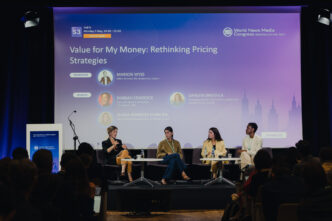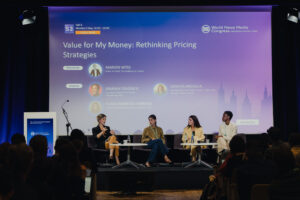

Tyler is the co-founder and CEO of beehiiv, previously being the 2nd employee at Morning Brew, building the infrastructure to grow and scale the company.
This article was originally published on Splice who work with the global media ecosystem to report on, teach, advise, transform, and fund media startups. Note that this interview was held in May 2022. Any out-of-date information has been removed or replaced & is in italics.
For someone starting a newsletter today, what are 2-3 things they should look for in a newsletter platform?
- Scalability — will the platform grow with you (in costs, incentives, flexibility, data, etc.) ?
- Complexity — Milk Road started on beehiiv with 0 subs in early 2022. 4 months later, they had over 130k.
They didn’t need to build a world class website with video embeds, or overcomplicate things with tons of integrations and bells and whistles. Instead they plugged into our tech and let us handle web hosting, emails, data, deliverability, styling, referrals, etc. Their time is better spent writing good content.
I think far too many people waste time spinning their wheels on things that don’t matter. I’d say, understand your competencies and maximize those, and find a platform that abstracts the rest.
> To add to your reading list: In conversation with 6am City – tech stack, audience strategy, and unit economics
What can newsletter platforms do to help distribute and market newsletters to other readers on the same platform? Is there a way to improve organic discovery?
So where beehiiv sits on this spectrum is purely on the Shopify / infrastructure side of things, not on the aggregator side. For example, when you shop at a shoe store hosted on Shopify they don’t tell you “you can also check out these 10 other shoe sites on Shopify” or “maybe you’ll like these shoes too!”
beehiiv is similar in that we provide the infrastructure and tools for you to spin up a top-of-the-line newsletter. Best-in-class deliverability, data analytics, subscriber attribution, etc. We also have a fully-integrated referral program to help you scale and incentivize readers to share and help you grow.
That being said, we’re not an aggregator. We’re not a destination for casual readers to find 15 different crypto newsletters. I actually think that part is solely on the creator/newsletter. I think you get in trouble as an aggregator suggesting certain types of content over others.we’re building tools for newsletters to connect with other newsletters and cross promote each other in some capacity, but that’ll come from the newsletters themselves, not beehiiv as a platform.
What advice do you have around pricing a newsletter subscription?
- What’s a standard subscription cost for media / information / entertainment going for? In the US most subscriptions from music streaming to video range in the $8 – $15 range, so as a comp, that’s a decent place to start
- How competitive is the space? For example, are you providing political insight that literally no one else is covering? If so, you could probably warrant a much higher price for that information because you’re a 1/1 (or at least 1/few). Alternatively if you’re just providing tech analysis, there’s a dime a dozen. Ben Thompson does a tremendous job, sending 3-4x a week, and charges $11 /mo, I believe. What’s the value and insight you’re providing relative to that?
- Who’s paying for it? Is it consumer facing where individuals are pulling out their cards to pay, or is it b2b and for work? If the latter, if your newsletter provides value in a work function, it’s possible the employer will pay for it, so you can charge a lot more.
- What’s the end game? Is subscription revenue your only revenue, or are you also selling ads? Are you selling courses? Are you cross promoting into different products? If you still want scale, but think you can warrant subscription revenue, maybe you intentionally price lower because you want to cross-sell other things.
How reliable are open rates given Apple’s privacy restrictions?
Simon Owens gives a more updated response here. In short, “Apple has declared war on email newsletters”.
“Apple recently announced new privacy updates to its iOS Mail app. Here’s how Digiday describes the changes:
With iOS 17 — which expands to public beta in July before the official launch in September — Apple will start automatically removing link trackers from URLs sent via Message and Mail as well as from links in Safari Private Browsing …
… Some marketers say removing URL parameters could make campaign analytics less reliable. Some of the “unintended impact” changes could include URL trackers related to ad measurement, embedded media, social widgets, fraud prevention, bot detection, audience measurement and funding websites that rely on targeted or personalized ads.
Apple is dead set on making it as difficult as possible for publishers and brands to measure the effectiveness of their newsletter strategies.
…Open rates and link tracking allow publishers to optimize their newsletters, and the latter also makes it easier for newsletter sponsors to track the effectiveness of their campaigns. By eliminating these features, Apple just seems to be giving more power to closed platform ecosystems that can track user behavior from end to end — platforms like Facebook, Instagram, YouTube, and TikTok.
Apple is basically hurting the decentralized web at a time when publishers are trying to become less dependent on the big tech platforms. I’m not sure consumers will be better off as a result.”
What should the key metrics be to track the success of a newsletter? Is it just open rates?
Depends on the type of newsletter. If you’re selling premium subscriptions, it might be the number of people who upgrade from free to paid, and the churn rate of your paid (you want to obviously minimize churn).
If it’s a free newsletter, then unique opens is probably important for you to monitor. Factor in unsubscribe rate, and lifetime value of the reader as well.
Also, if you’re selling ads, you’d probably prefer people who click and engage on ads more, because it makes your newsletter more attractive to advertisers (because they’re seeing success).
That’s a whole jumble of answers but truth is there aren’t a ton of metrics in email to start with, so know what moves the needle for you and optimize for that.
Have you seen any recent examples of unique/creative rewards for referrals beside the usual branded merchandise? Who does this well?
Going back to Milk Road as an example: they only have a single reward at 1 referral (an ebook) and they have over 10k referrals. They made it super simple, attainable, and it’s a slam dunk. Matthew Berry Fantasy Life is another fantasy football newsletter in the early stages of spinning up a referral program. They are offering unique fantasy insights and tips, and opportunity to speak with Matthew Berry.
What’s important is understanding your audience and aligning with what they want. It’s probably not another t-shirt or mug.
How would you go about growing a local newsletter email list on a tight budget?
- Great sharable content
- Cross-promote with other newsletters
- Experiment with incentives and rewards
- SEO
- Any sort of collabs in the community
- Partner with local businesses, if possible
> A 6-step plan for local news email newsletters to go from content strategy to growth
How does beehiiv work in segregating and teasing content for paid and non-paid subscribers?
Similarly to Substack, you can have a premium-only post. Alternatively, you can send a newsletter to both free AND premium, but drop a teaser line in the content so anything below the line is only accessible to paying readers, otherwise free readers are hit with an upgrade nudge.
In terms of engaging an audience, what are the challenges when the scale is so big? How do you keep the intimate flow of the conversation that characterizes a newsletter when the audience is so massive? Is that even possible?
One of hardest problems for a ton of businesses is scaling “exclusivity” or “intimacy”. I’m not trying to intentionally tie everything back to beehiiv, but this is something we’ve thought a lot about.
It’s not a perfect solution but it’s something: 1-click polls, essentially making it super easy to collect info and data on your readers.
It could be something as silly as “chicken sandwich vs burger?”, but being able to then take the results and share them in the next newsletter is, I think, a cool mechanism for that independent reader reading in a silo to feel somewhat connected with other strangers reading the same thing.
The comment section is another, although I have mixed feelings about it. I think most online comment sections are mostly spam and not productive, but there are instances of great comment sections that I do think drive engagement.
How is the transition for paid newsletters from Substack to beehiiv? Do you have any mechanisms for potential subscribers to discover newsletters?
Something we prioritized early on was that you can migrate over from Substack in just 3 steps (~5 minutes)
- Import CSV of subscribers (exportable from Substack)
- Drop URL of Substack and we’ll pull over all your content
- alternatively, if some of your content lives behind a paywall, you can import a zip file of your content (exportable from Substack)
- Migrate premium subs (we have a mechanism to do this and our CTO will even white-glove and do it with you)
- Readers don’t get notified of any change
- Their billing cycle and payment method remains the same
- No disruption to existing subs
This article was originally published on Splice, who help to build viable media startups in Asia, working with the global media ecosystem to report on, teach, advise, transform, and fund media startups.












